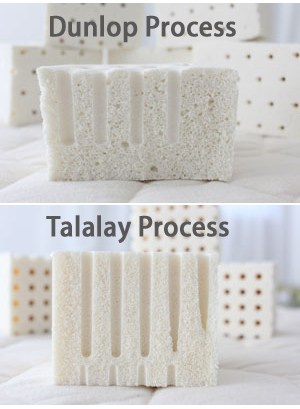 If you are in the market for a latex mattress the biggest question you probably want to know is what’s the difference between Talalay and Dunlop. I am sure you have already went over to the google machine and started some research of your own. If you have, you may be getting conflicting information about which is better.
If you are in the market for a latex mattress the biggest question you probably want to know is what’s the difference between Talalay and Dunlop. I am sure you have already went over to the google machine and started some research of your own. If you have, you may be getting conflicting information about which is better.
On one hand you have all the Talalay supporters stating their case why they think Talalay is better and on the other side you have the Dunlop supporters saying Dunlop is better. While their argument is going on you are caught in the middle of them just trying to find out what are the differences between the two. From the sound of their arguments you would think they were talking about their preferred political party or some pressing social issue.
I don’t blame you if you have second thoughts on buying a latex mattress since I am sure you don’t want to be associated with those Latex freaks. Well, before you reconsider I am here to give you the differences between the two and also share the advantages and disadvantages of both. At the end, I will also go over which method I prefer. So let’s get started.
Talalay Latex
Talalay is one of the processes in which a Latex mattress is made and should not be confused with synthetic latex or all natural latex. It is a seven-step process, which makes it more complex than that of Dunlop. The steps of the Talalay process are:
1) First it is whipped into a frothy liquid
2) Next the liquid is poured precisely by robotic arms into the mold
3) Then the mold is closed and gets vacuum sealed so that the Latex gets distributed evenly
4) It is then chilled to -20 degrees
5) After which, CO2 is introduced to gel the Latex foam
6) It is then heated to 220 degrees to cure the Latex final shape
7) Lastly it is washed and dried
Advantages of Talalay
- More breathable than Dunlop due to the manufacturing process
- Wider range of ILDs. However, Talalay is still softer than Dunlop even if they are both labeled as the same ILD.
- Conforms to the body better since it is more “airy”
- More consistent feel throughout the mattress
- Usually better having Talalay in the comfort layer due to its “pushiness”
- Softer
Disadvantages of Talalay
- More expensive than Dunlop
- Softer
- Less dense
Dunlop Latex
The Dunlop method has been used since 1929. The Dunlop process is about four times quicker to manufacture than Talalay. The steps of the Dunlop process is as follows:
- First the Latex liquid is emulsified
- Next it is poured into the mold
- The mold is then closed and gets cooked evenly
- Finally the Latex is removed from the mold and is washed and dried
Advantages of Dunlop
- More dense
- Less Expensive
- Usually better used as the support layer in the mattress due to its density
- Firmer
Disadvantages of Dunlop
- Not as breathable
- Inconsistent feel throughout the mattress due to the particles settling at the bottom
- Firmer
Although it looks like Talalay is the better method of the two, you have to find out what is best for you. You may like the firmer feel and choose to go with the Dunlop process. My preferred combination is having a Dunlop core with the comfort layers being Talalay. The reason I like it that way is because Dunlop is more dense it gives me that firmer support while I can still benefit from the plush feel of Talalay on the top layers.
